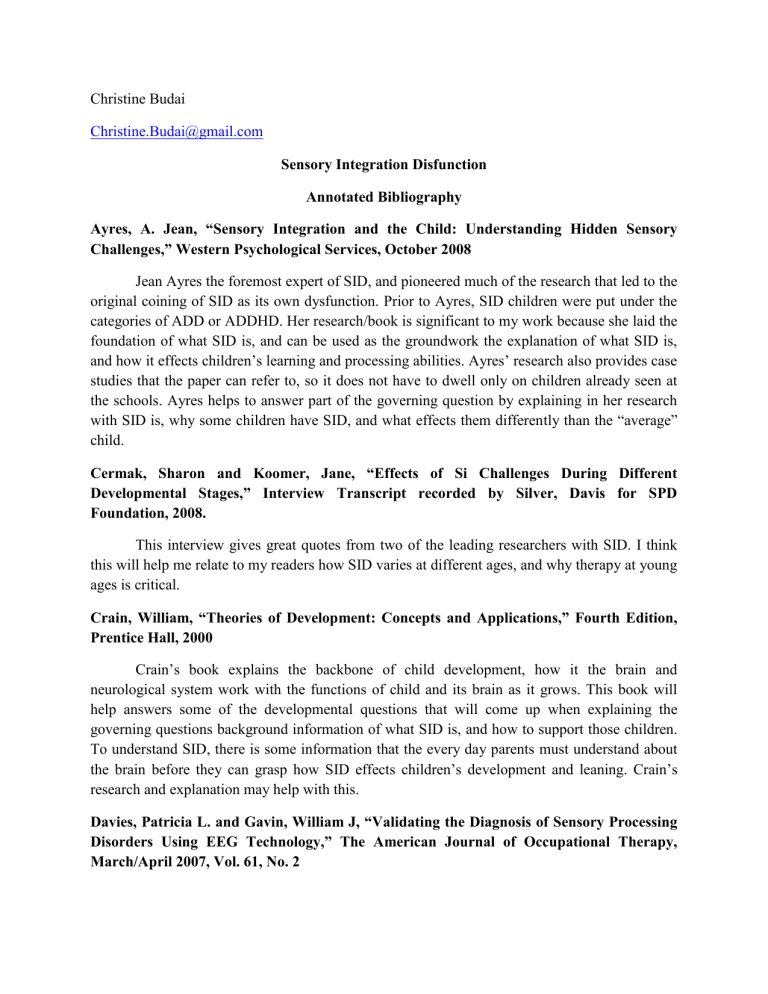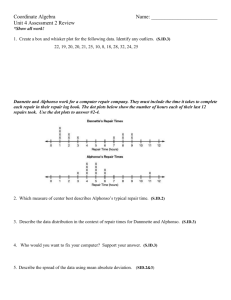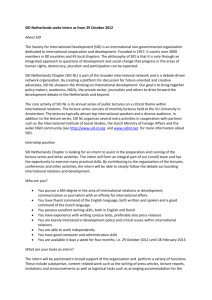SID+Annotated+Bibliography+Budai

Christine Budai
Christine.Budai@gmail.com
Sensory Integration Disfunction
Annotated Bibliography
Ayres, A. Jean, “Sensory Integration and the Child: Understanding Hidden Sensory
Challenges,” Western Psychological Services, October 2008
Jean Ayres the foremost expert of SID, and pioneered much of the research that led to the original coining of SID as its own dysfunction. Prior to Ayres, SID children were put under the categories of ADD or ADDHD. Her research/book is significant to my work because she laid the foundation of what SID is, and can be used as the groundwork the explanation of what SID is, and how it effects children’s learning and processing abilities. Ayres’ research also provides case studies that the paper can refer to, so it does not have to dwell only on children already seen at the schools. Ayres helps to answer part of the governing question by explaining in her research with SID is, why some children have SID, and what effects them differently than the “average” child.
Cermak, Sharon and Koomer, Jane, “Effects of Si Challenges During Different
Developmental Stages,” Interview Transcript recorded by Silver, Davis for SPD
Foundation, 2008.
This interview gives great quotes from two of the leading researchers with SID. I think this will help me relate to my readers how SID varies at different ages, and why therapy at young ages is critical.
Crain, William, “Theories of Development: Concepts and Applications,” Fourth Edition,
Prentice Hall, 2000
Crain’s book explains the backbone of child development, how it the brain and neurological system work with the functions of child and its brain as it grows. This book will help answers some of the developmental questions that will come up when explaining the governing questions background information of what SID is, and how to support those children.
To understand SID, there is some information that the every day parents must understand about the brain before they can grasp how SID effects children’s development and leaning. Crain’s research and explanation may help with this.
Davies, Patricia L. and Gavin, William J, “Validating the Diagnosis of Sensory Processing
Disorders Using EEG Technology,” The American Journal of Occupational Therapy,
March/April 2007, Vol. 61, No. 2
In this article Davies and Gavin explore the assumption of sensory integration theory that states that a “relationship exists between brain functions and the behavioral manifestations” of
SID (Davies, Gavin). This article may help me add some more scientific based data to my report, in addition to the observation based information that I have so far. Davis and Gavin use electoencephalographic measures between physical input and actions, and how the brain processes them to measure brain activity and patterns within 25 children with SID between the ages of 5-12.
Dunn, Winnie and Tomcheck, Scott, “Sensory Processing in Children with and without
Autism: A Comparative Study Using the Short Sensory Profile,” The American Journal of
Occupational Therapy, March/April 2007, Vo. 61, No. 2, p. 190-200
In this article Dunn and Tomcheck explore the differences between SID in children with and without autism. This article could help me explain how children may have been missdiagnosed with autism in the past, and how SID does not mean that a child cannot live a normal live and grow into a fully-functioning adult.
Kinnealey, Moya and Miller, Lucy, “Sensory Integration/ Learning Disabilities,” Williard
& Speckman’s Occupational Therapy, Philadelephia, J.P. Lippincott Co, 8 th edition, 1993, p. 474-489
In Kinnealey and Miller’s article, the two explore not just what SID is, but also the diagnostic measure used to diagnose a child with SID. I think this article is helpful because while
I have a lot of information on what SID is, I do not have much on how medical professionals/
OT/PT actually diagnose a child with SID. I think this will validate some of the educational therapies that I outline and suggest within my paper.
Koomer, Jane, “Answers to Questions Teachers Ask About Sensory Integration: Forms
Checklists and Practical Tools,” Future Horizons Inc, 2007
So far this source is answering the governing questions “what can teachers and parents do to support children with SID.” This book not only has checklists that are helpful resources for behavioral assessments of children who may have SID, but it also specifically outlines what teachers can do to make their curriculum more inclusive to students with SID.
Kranowitz, Carol, “The Out-of-Sync Child, Recognizing and Coping with Sensory
Integration Dysfunction,” Berkley Publishing Group, 1998
Kranowitz’s book is significant because it helps to answer the question “What can teachers and parents do to be supportive of children with SID.” The book outlines helpful coping
mechanisms for children, as well as tools that teachers and parents can use to help both themselves and the children adjust to living in a world with SID, and children with SID.






